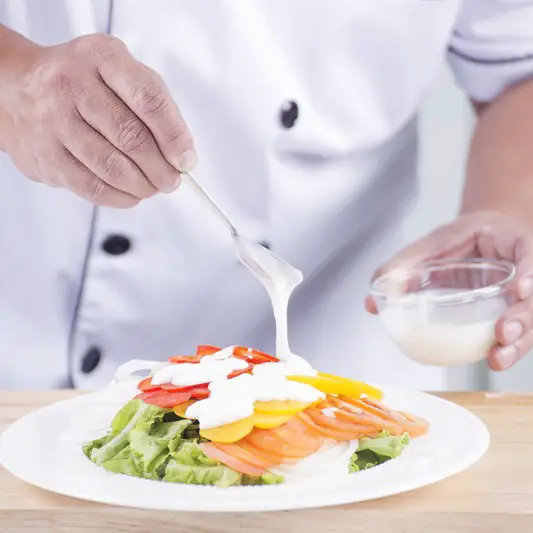You may think you’re making a healthy choice by ordering a salad at a restaurant, but have you considered the calorie bomb lurking in your salad bowl? That’s right, we’re talking about the salad dressing. While a drizzle of dressing can add flavor and zest to your greens, many restaurant salad dressings are laden with calories, fat, sugar, and sodium, turning your nutritious meal into a diet disaster. Let’s take a closer look at the worst offenders and learn how to navigate the salad dressing minefield.
1. Creamy, Cheesy Dressings
Creamy dressings like ranch, blue cheese, and Caesar are often the worst offenders when it comes to unhealthy salad toppers. These dressings are typically high in calories, saturated fat, and sodium due to their base of sour cream, buttermilk, cheese, and eggs. Just two tablespoons of Marie’s Creamy Ranch dressing contains a whopping 170 calories and 19 grams of fat!
If you can’t resist the tangy, creamy flavor of these dressings, try opting for a yogurt-based version or making your own with Greek yogurt, herbs, and spices. You’ll still get the satisfying creaminess without the extra fat and calories.
Another strategy is to ask for the dressing on the side and use it sparingly. Dip your fork into the dressing before each bite, rather than drowning your salad in it. A little goes a long way when it comes to these indulgent dressings.
2. Sugary Vinaigrettes
Don’t be fooled by the word “vinaigrette” – many of these dressings are loaded with sugar, often in the form of high fructose corn syrup. Wish-Bone Sweet French dressing, for example, packs in 9 grams of sugar per serving, along with unhealthy fats and sodium.
When choosing a vinaigrette, look for ones made with healthy oils like olive oil or avocado oil, and that use natural sweeteners like honey or fruit juices in moderation. Better yet, make your own by whisking together equal parts oil and vinegar, and adding a touch of Dijon mustard and herbs for flavor.
Remember, even “healthy” fats like olive oil are high in calories, so use them sparingly. One tablespoon of olive oil contains 120 calories, so that “light” drizzle can quickly add up.
3. Sodium Bombs
Many restaurant salad dressings are shockingly high in sodium, which can contribute to bloating, water retention, and high blood pressure. Olive Garden Parmesan Ranch, for instance, has 540 milligrams of sodium per serving – that’s nearly a quarter of your daily recommended intake!
When dining out, ask for the dressing on the side and use it sparingly, or opt for a squeeze of lemon juice or vinegar instead. At home, make your own dressings using herbs, spices, and citrus juices for flavor, rather than relying on salt.
Pay attention to serving sizes, too. Even a seemingly harmless dressing can pack a sodium punch if you use too much. Stick to the recommended serving size of 1-2 tablespoons to keep your sodium intake in check.
4. Fried, Crispy Toppings
While not technically a dressing, fried toppings like crispy chicken, croutons, and wontons can turn a healthy salad into a fat and calorie bomb. These toppings are often deep-fried and coated in breading, adding unnecessary calories and unhealthy fats to your meal.
Opt for grilled, baked, or roasted proteins instead of fried ones, and choose nuts or seeds for crunch instead of croutons. If you can’t resist the crispy texture, use just a small handful of your favorite topping and savor each bite.
Remember, a salad is only as healthy as its components. Don’t let fried toppings sabotage your healthy intentions.
5. Misleading “Healthy” Options
Just because a dressing is labeled “organic,” “natural,” or “gluten-free” doesn’t necessarily mean it’s healthy. Many of these dressings can still be high in calories, fat, and sugar, so it’s important to read the nutrition label and ingredient list carefully.
Look for dressings made with whole, recognizable ingredients, and that are low in added sugars and unhealthy fats. Don’t be swayed by health claims on the label – let the nutrition facts be your guide.
When in doubt, make your own dressing using simple, wholesome ingredients like olive oil, vinegar, herbs, and spices. That way, you know exactly what you’re putting on your salad.
6. Supersized Portions
Even a healthy dressing can become unhealthy if you use too much of it. Restaurant salads often come with a whopping 4-6 tablespoons of dressing, which can add hundreds of calories to your meal.
To control your portions, always ask for the dressing on the side, and use just 1-2 tablespoons. Dip your fork into the dressing before each bite, rather than pouring it all over the salad. This way, you’ll still get the flavor without drowning your greens in excess calories.
7. Deceptive “Light” Dressings
Don’t be fooled by dressings labeled “light” or “low-fat” – these versions often compensate for the lack of fat by adding extra sugar, salt, and artificial ingredients. In some cases, the light version can have more calories and sugar than the regular version!
Instead of relying on these misleading labels, read the nutrition facts and ingredient list to make an informed choice. Better yet, make your own light dressing using a mix of vinegar, citrus juice, and herbs, with just a touch of healthy oil for richness.
The bottom line? When it comes to restaurant salad dressings, it pays to be a savvy consumer. Don’t let a deluge of dressing drown out your healthy intentions. By being aware of the worst offenders and making smart swaps, you can enjoy a flavorful, nutritious salad without the side of guilt. Now if you’ll excuse me, I have a date with a bottle of balsamic vinegar and a sprig of fresh basil.

